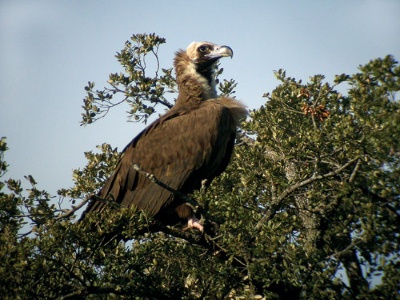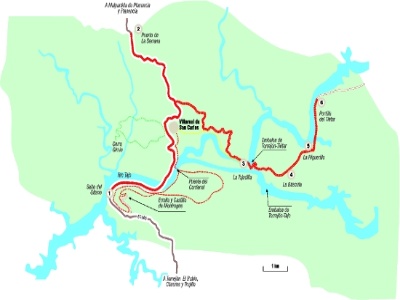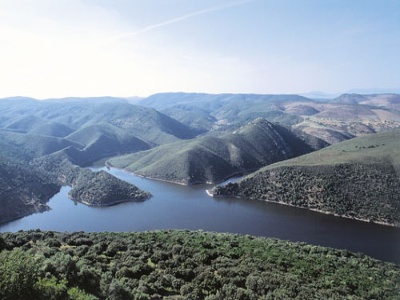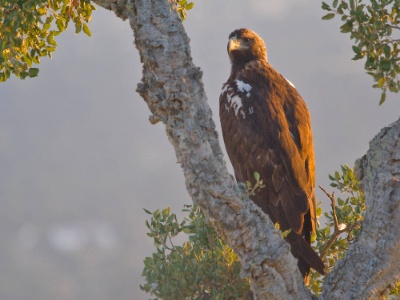National Monfragüe Park
Travellers
National Monfragüe Park
Location and access
Monfragüe is roughly in the centre of the province of Cáceres, at the confluence of the rivers Tajo and Tiétar. It is at present the only National Park in Extremadura, with 18,118 ha under this protection. The park and its immediate surrounding area, a total of 116,151 ha, are protected by the Natura 2000 network as a SPA. The centre of the park consists of several small, parallel mountain ranges, between which flows the River Tajo. The River Tiétar and other lesser watercourses carve out deep gorges as they flow towards the Tajo, creating a spectacular system of rocky cliffs in which a huge number of birds breed. Nowadays the river courses are dammed up by the reservoirs of Alcántara, Torrejón-Tajo and Torrejón-Tiétar. Despite the area’s low height, the uneven relief and the water barrier has meant that areas of Mediterranean forest and scrubland of extremely high value in terms of their fauna and flora have been conserved. But what really gives the area its value are the large dehesa areas that extend to the north and south of the National Park, providing an abundant food supply for Monfragüe’s most valuable birds.
Access to Monfragüe is easy and well sign-posted. Within the park there is only one town, Villarreal de San Carlos, a municipality of Serradilla, which is small and completely connected to the park, accommodating the visitor centre and centre of interpretation. There are three roads you can take to get into the park. From the north, by the EX–208, about 20 km from Plasencia and 15 km from the EX-A1. From the south, also by the EX-208, but from Trujillo, about 50 km away, after going through Torrejón el Rubio. Or finally, from the northeast, by a small road leading off from the EX-A1, the exit being by the River Tiétar. Also, from the south, the EX-390 connects the city of Cáceres with Torrejón el Rubio and the EX-385 connects the EX-208 with the A-5, passing through Jaraicejo.
Description of the route
Most of the National Park is closed to visitors, with the area open to the public being relatively small. However, this area offers all the best of the birds of Monfragüe. In fact, there are some world famous birdwatching spots here, thanks to the ease of observing some emblematic birds in exceptional conditions.
Due to the restrictions the best way of enjoying a birdwatching trip to Monfragüe is to go round the main viewpoints, all along the road, well sign-posted and equipped with car parks. If visiting for several days the normal choice is to repeat the route round the viewpoints or to do one of the established walking routes in the park or the surrounding area. The species you can see in various places can vary slightly from year to year, as, like any biological phenomenon, they are subject to a certain dynamism
The park’s main viewpoints, from south to north, are:
Salto del Gitano-Peña Falcón. At the entrance from Trujillo, this incredible rocky cliff is, without doubt, the most symbolic and most-photographed spot in Monfragüe. The community of birds it supports is equally amazing, with the biggest colony of Griffon Vulture in an area open to the public (over 100 pairs between both sides of the river and over 400 birds at times), Black Stork (2-5 pairs in recent years), Spanish Imperial Eagle, Bonelli’s Eagle, Peregrine Falcon, Egyptian Vulture and Eagle Owl. It is also possible to see Golden Eagle. Small birds you should look out for include White-rumped Swift and Black Wheatear.
La Serrana. At the entrance from Plasencia, here there are Griffon Vulture, Egyptian Vulture and, at times, Bonelli’s Eagle and White-rumped Swift.
La Tajadilla. Next to the Torrejón reservoirs, this has a hide, picnic area and large car park. It is a small gorge that enables good observations of Griffon Vulture and Egyptian Vulture, also being a good area to see Bonelli’s Eagle. Black Stork and White-rumped Swift have recently established themselves here, but their presence could be temporary.
La Báscula. This is a good site to see the Eurasian Black Vulture and, if you are lucky, the Spanish Imperial Eagle. La Higuerilla. This affords a pretty view of the River Tiétar, where you can see Black Stork and Egyptian Vulture. Eurasian Black Vultures breed on the opposite bank.
La Higuerilla. This affords a pretty view of the River Tiétar, where you can see Black Stork and Egyptian Vulture. Eurasian Black Vultures breed on the opposite bank.
Portilla del Tiétar. At the park’s northeast exit, although it is smaller than the Peña Falcón, it is another of Monfragüe’s hot spots. It’s an exceptional site to see, and hear, Griffon Vulture as well as Spanish Imperial Eagle, Eagle Owl (the best place in the park) and Egyptian Vulture.
We would also recommend you to follow the road towards La Bagazona and the EX-A1, driving slowly, or even walking carefully, as this section goes firstly through an old cork oak forest where Lesser Spotted Woodpecker breeds and, perhaps, the Iberian Chiffchaff. Next there is a dehesa area that is a favourite haunt of stags during their bellowing and where there is a colony of White Stork and Grey Heron in the west, next to the River Tiétar. The final part consists of deshesa and irrigated farmland and is of interest in winter due to the recent presence of noisy Common Cranes, as well as Brambling some years.
You could complement your tour of the viewpoints mentioned earlier by doing the three main foot trails:
Red route. This is between Villarreal de San Carlos and the castle of Monfragüe. There are several options, with routes of between 10 and 16 km (between 3 h 30 min and 6 hours). It goes through a variety of areas, such as olive groves, rock rose patches, Holm oak groves and, in particular, a thick forest of strawberry tree and oaks in the shade of the castle. A visit to the castle of Monfragüe is a must, which you can also reach from the south via an asphalted road between Holm oaks and wild olives. The view from the castle is magnificent and is made even more enjoyable by the spectacular flight of the vultures and the possible presence of White-rumped Swift and Red-billed Chough.
Yellow route. This is between Villarreal and La Tajadilla, about 8.5 km and 3 hours there and back. This route goes through dehesa and rock rose patches.
Green route. Between Villarreal and Cerro Gimio, about 7 km and 2 h 30 minutes there and back. It goes through scenery typical of Monfragüe, ending at a viewpoint with a beautiful view.
Ornithological interests
Monfragüe is possibly the best place to see birds, particularly birds of prey, in Extremadura. The following figures fully illustrate their variety and abundance. Perhaps the most characteristic species is the Eurasian Black Vulture, with a maximum of 339 pairs for certain and estimates of over 400 pairs. There are 12 established pairs of Spanish Imperial Eagle, with some recently settled near to the best viewpoints. There are more than 30 pairs of Egyptian Vulture and close to this number of Black Stork. The most visible bird of prey is, undoubtedly, the Griffon Vulture, of which there are 635 pairs for certain and estimates of almost 800. There are small numbers of Golden Eagle (6-7 pairs), Bonelli’s Eagle (also 6-7 pairs) and Peregrine Falcon (3-4 pairs). There aren’t any precise figures for other birds of prey, but several dozen pairs of Eagle Owl, Red Kite, Common Buzzard, Booted Eagle and Short-toed Eagle occur in Monfragüe, above all in the dehesa in the area. The Black Kite is a lot more common, with 150-200 pairs; but Northern Goshawk, Eurasian Sparrowhawk and Black-winged Kite are much scarcer and more difficult to see.
Apart from birds of prey, other birds of interest are those of rocky habitats, such as White-rumped Swift, Red-billed Chough, Black Wheatear, Blue Rock Thrush, Rock Sparrow, Red-rumped Swallow and Black Redstart. The forest birds are less special, as most of them are common all over Extremadura, however, they include Western Orphean Warbler, Lesser Spotted Woodpecker, Iberian Chiffchaff, Hawfinch and Eurasian Bullfinch. Some birds of open and steppe environments are more important, easy to see in treeless areas of the park where the eucalyptuses are being eliminated. These are Black-eared Wheatear, Thekla Lark and Spectacled, Dartford, Subalpine and Sardinian Warblers.
Best time to visit
Spring, between March and May, is the best time to see all the variety of birds. However, it’s also the busiest time for visitors, especially at the weekends and during the public holidays at Easter and in May. In any event, you can see characteristic species at any time of the year, although in July and August it is best to make the most of the first and last hours of the day, as the middle of the day is usually very hot. Autumn and winter offer the attraction of non-breeding species being present in the area. Finally, between September and October the spectacular bellowing of the many stag in the area takes place.
Other environmental and cultural interest
As well as the birds you can see other animals in Monfragüe, such as approachable Red Deer, some tame foxes that frequent the viewpoints, elusive Wild Boar and, particularly in winter, Otters. On the other hand, there have not been any reliable sightings of the emblematic Iberian Lynx recently. Other attractions of Monfragüe are the scenery, spectacular in places, and the geological formations, with explanatory panels in the places of greatest interest. There are also two special trees: the European Hackberry of Lugar Nuevo (next to Villarreal de San Carlos, in Ojaranzo orchard, which has a circular trail and a small picnic area) and the Cork oak Abuelo de Toril (next to the road between Portilla del Tiétar and La Bazagona).
The main artistic elements within the park are the castle of Monfragüe, the Bridge del Cardenal (sometimes submerged under the waters of the Tajo) and the prehistoric rock art, for which there are specific guided tours. Places of interest in the municipal areas just outside the park include the pre-Roman stelas and settlement of Torrejón el Rubio, the Convent del Santo Cristo and the ethnographical museum of Serradilla, the parish churches of Serrejón and Malpartida de Plasencia, Mirabel Castle and the traditional architecture of the Casas of Miravete. The monumental architecture of Plasencia and Trujillo are a bit further away.
Food specialities are cheeses, honey, “migas extremeñas” (fried breadcrumbs) and large game dishes. Las Candelas in Torrejón el Rubio and Cristo de la Victoria in Serradilla are the most notable festivals. Regarding handicrafts, in some of the towns and villages in the area you can find wood and textile works (lace, traditional dress).




